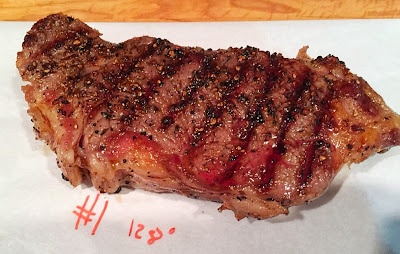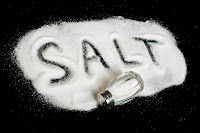Sous-Vide "VS" Reverse-Sear
This experiment (using this word loosely) and of course desire to write this post came to be because of a discussion we were all having on Facebook. The Facebook group that was the catalyst to this post is called Sous-Vide, Meat Curing, Smoking and BBQ......great group of people that love to discuss food and of course cook. From beginners cooks to Professional chefs this is a great place to learn and dialogue about food.
By examining the different cooking styles and techniques I will be able to make an informed opinion as to which practice is better and maybe outline some pros and cons. Please take the results of this as more of an observation and only one mans opinion.
By examining the different cooking styles and techniques I will be able to make an informed opinion as to which practice is better and maybe outline some pros and cons. Please take the results of this as more of an observation and only one mans opinion.
I will make every effort to be studious. My note taking will be precise. I will use measuring equipment to record results. I will take pictures for posterity. And you have my word I will be unbiased and as sincere as humanly possible. OK, where do I sign.
So what exactly will I be doing? I will Cook four steaks using two different cooking techniques and salting methods. Steak #1 will be salted (dry-brine for 24 hours) using 1% of Kosher salt and Sous-Vide at 128 degrees for 100 min. Steak #2 will be Sous-Vide exactly the same but with No Dry-Brine.
Steak #3 will be salted like Steak #1 but will be Reversed Seared. And finally Steak #4 will be Reversed Seared and NO Dry-Brine like steak #2. The only salt I will add to Steak #2 and #4 will be when I sear them off for Maillard reaction. I will of course add pepper because I am gonna eat the steaks and can't let them go to waste. I hope this is clear.
I also plan on weighing them pre/post cooking and sear to calculate moisture loss. I'm curious about the effects of dry-brining and how it relates to moisture loss.
In previous trials the Dry-Brined steaks are always juicier. I also want to quantify moisture loss as it relates to the cooking technique....Sous-Vide vs Reverse Sear. Some variables to consider. The longer the meat sits in the water bath the greater the moisture loss. The higher the temp of the water bath the greater the moisture loss.
The whole SV experiment could be just a waste of time depending on the temps and times you choose. Meaning: With SV if you choose a long cook or high water temp it will dry out the meat. So use caution when making choices. Your choices could change the conclusions. I chose these times and temps based on previous experience and expert knowledge to bring out the best unbiased results.
Note: I have cooked meat using all of these techniques but I have never done them for a side by side comparison.

ONE MANS CONCLUSIONS
Steak #3 will be salted like Steak #1 but will be Reversed Seared. And finally Steak #4 will be Reversed Seared and NO Dry-Brine like steak #2. The only salt I will add to Steak #2 and #4 will be when I sear them off for Maillard reaction. I will of course add pepper because I am gonna eat the steaks and can't let them go to waste. I hope this is clear.
I also plan on weighing them pre/post cooking and sear to calculate moisture loss. I'm curious about the effects of dry-brining and how it relates to moisture loss.
In previous trials the Dry-Brined steaks are always juicier. I also want to quantify moisture loss as it relates to the cooking technique....Sous-Vide vs Reverse Sear. Some variables to consider. The longer the meat sits in the water bath the greater the moisture loss. The higher the temp of the water bath the greater the moisture loss.
The whole SV experiment could be just a waste of time depending on the temps and times you choose. Meaning: With SV if you choose a long cook or high water temp it will dry out the meat. So use caution when making choices. Your choices could change the conclusions. I chose these times and temps based on previous experience and expert knowledge to bring out the best unbiased results.
Note: I have cooked meat using all of these techniques but I have never done them for a side by side comparison.
I am using the Certified Angus Beef (choice) New York Loin for this test.
Note 1: All steaks are 1 1/2 inch thick.
Note 2: Steak 1 & 2 will be Sous-Vide at 128 degrees. Steaks 3 & 4 will be roasted in a 170-180 degree oven until an internal temp of 115 degrees in reached.
Note 3: Steak 1 & 3 are dry-brined with 1% Salt.
Note 4: Steak 2 & 4 no salt prior to SV or roast.
Note 5: All steaks received pepper before Pan Sear. Steak 2 & 4 received salt just before Pan Sear.
Note 6: All steaks received a 10 min rest after roast, SV and Sear.
Note 7: All steaks seared for 85-90 secs per-side.
Note 8: TML= Toal Moisture Loss
Note 9 : All steaks were dried thoroughly before searing and weighing.
Note 8: TML= Toal Moisture Loss
Note 9 : All steaks were dried thoroughly before searing and weighing.
Sous-Vide at 128 degrees 1% dry-brine
Weight before cooking 417g = 100%
Weight after SV and dried 408g = 97.84%
Weight after Sear 383g= 91.84%
TML = 8.16%
TML = 8.16%
Sous-Vide at 128 degree NO SALT
Weight before cooking 362g = 100%
Weight after SV 340g = 93.92 %
Weight after Sear 311g =85.91%
TML= 14.09%
TML= 14.09%
Roasted at 170-180 degree oven 1% dry-brine to internal temp of 115 degrees.
Weight before cooking 342g = 100%
Weight after Roast 328g = 95.90%
Weight after Pan Sear 306g = 89.47%
TML= 10.53%
TML= 10.53%
Roasted at 170-180 degree oven to internal temp of 115 degrees. Salted after Oven Roasting.
Weight before cooking 308g = 100%
Weight after Roast 289g = 93.83%
Weight after Pan Sear 268g = 87.01%
TML= 12.99%
TML= 12.99%

ONE MANS CONCLUSIONS
Where to start? I ate all the steaks. HaHa.... yea I did. With the help of my wife and kids I think I reached some conclusions. Regardless of techniques they were all good. Lets discuss numbers and salt. Obviously Dry-Brining yields a great percentage of moisture retention.
I will compare the steaks by the following scale. Fair, Good, Better and Best and Outstanding. I will rate them on Taste, Texture, Juiciness and Overall enjoyment.
Steak # 1- Taste- Best, Texture-Best, Juiciness- Best, Overall- Best
Steak # 2 Taste- Good, Texture- Better, Juiciness- Better, Overall-Better
Steak # 3 Taste- Outstanding, Texture- Outstanding, Juiciness- Best, Overall- Outstanding
Steak # 4 Taste- Fair, Texture-Good, Juiciness-Good, Overall-Good
So did we reach some conclusions? We sure did!!! I loved Steak #3 and it was the best out of the four steaks. Steak #1 was a close second. Dry-Brining added greater moisture retention for both # 1 & # 3. Dry-brining added tremendous flavor benefits to Steak # 3 but not so much for Steak # 1 which was SV. Dry-Brining SV Steak only adds a little extra moisture but no added flavor in my opinion but won't hurt it if you do it, Note: Steak # 1 was better than Streak # 2. Ahhh.... Steak # 3 was a WOW!!! Dry-Brining really added tremendous flavor and moisture retention. Steak # 4 ?? Nothing to write home about. Did you notice that the non-brined SV steak #2 lost more moisture than the oven roasted one #4 ?
Some things to consider. I was working with tender meat and long SV times were not needed. I only SV to core temp which was 100 minutes. Don't forget moisture will will increase significantly the longer the meat sits in the water bath.
So if I was working with a less tender piece of meat I would definitely Dry-Brine. I think the Reverse Sear is great for certain types of meat like.. I.E New-York's, T-Bones, Porterhouses, Fillets, and Ribeye's (maybe). Only tough cuts need to be SV and Dry-Brined in my opinion.
Order of preface- Steak #3 Clearly the winner, coming in second Steak #1, Steak #2 and last place is Steak #4.
Future experiment- So a thought crossed my mind the other day. Regarding moisture loss and SV. I have come across comments and complaints that SV dries out meat. Well this can be true if you over SV a piece of meat. We all know that the internal temp will not rise but the time spent in the bath can at times adversely effect texture and moisture. The consequence of using higher temps/time in bath will result in additional and unwanted moisture loss. Yes there are certain cuts that benefit from long cooks but I am not talking about these meats. I want to run an experiment that uses tender steaks New York, T-Bone, Porterhouse or fillet to test out my theory. I will make sure they are all cut from the same primal to ensure similar fat and marbling. I will cook 5 steaks at one temp with five different cooking times and calculate moisture % loss.
So if I was working with a less tender piece of meat I would definitely Dry-Brine. I think the Reverse Sear is great for certain types of meat like.. I.E New-York's, T-Bones, Porterhouses, Fillets, and Ribeye's (maybe). Only tough cuts need to be SV and Dry-Brined in my opinion.
Order of preface- Steak #3 Clearly the winner, coming in second Steak #1, Steak #2 and last place is Steak #4.
Future experiment- So a thought crossed my mind the other day. Regarding moisture loss and SV. I have come across comments and complaints that SV dries out meat. Well this can be true if you over SV a piece of meat. We all know that the internal temp will not rise but the time spent in the bath can at times adversely effect texture and moisture. The consequence of using higher temps/time in bath will result in additional and unwanted moisture loss. Yes there are certain cuts that benefit from long cooks but I am not talking about these meats. I want to run an experiment that uses tender steaks New York, T-Bone, Porterhouse or fillet to test out my theory. I will make sure they are all cut from the same primal to ensure similar fat and marbling. I will cook 5 steaks at one temp with five different cooking times and calculate moisture % loss.
















Comments
Post a Comment